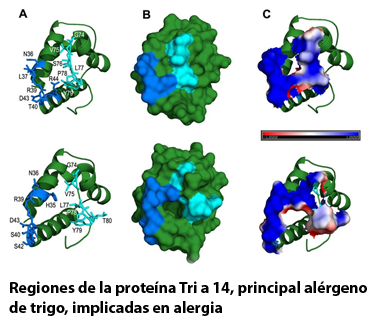Wheat allergens associated with Baker’s Asthma
UPM-INIA researchers have identified wheat allergens which will improve the diagnosis and treatment of baker’s asthma, a frequent occupational allergic disease.
Baker’s asthma is an occupational allergic disease caused mainly by inhalation of cereal flour, particularly wheat flour. This research focuses on the current diagnosis and immunomodulatory treatments, as well as the role of wheat allergens as molecular tools to enhance management and knowledge of this disease. Researchers of Centre for Plant Biotechnology and Genomics UPM-INIA have identified some of these wheat allergens to improve the diagnosis and treatment of disease.
A wheat allergy encompasses a group of heterogeneous conditions (allergen by ingestion associated with daily exercise, baker’s Asthma) that must be characterized individually and which are not related to celiac disease.
Baker’s Asthma is a common occupational allergen and the number of cases continues to rise. Patients have mild symptoms such as hives and atopic dermatitis and severe symptoms, for example, vomits and anaphylaxis (systemic allergic reaction).
 Now, the diagnosis of this disease is based on skin prick tests and specific inhalation challenge of wheat flour. However, the result depends on the quality of the cereal extract used, due to the lack of standardization. The nasal challenge test with isolated allergens is still considered the gold standard for the diagnosis of baker’s asthma. The recommended treatment is to avoid exposure to flour, but this would mean the loss of employment.
Now, the diagnosis of this disease is based on skin prick tests and specific inhalation challenge of wheat flour. However, the result depends on the quality of the cereal extract used, due to the lack of standardization. The nasal challenge test with isolated allergens is still considered the gold standard for the diagnosis of baker’s asthma. The recommended treatment is to avoid exposure to flour, but this would mean the loss of employment.
The specific immunotherapy against allergens is a great alternative to avoid symptoms resulting from a prolonged exposure to wheat flour. To develop this alternative it is essential to define the role of each allergen during the wheat allergy. This will help to characterize the relationship between sensitization profile and predisposing factors, the potential cross-reactivity among different allergens and possible changes in the allergenic activity (processed products derived from wheat), which will develop hypoallergenic varieties.
Numerous wheat allergens are involved in Baker’s asthma, for example, plant storage proteins (prolamins, albumins and globulins) and defensive proteins against pathogens (lipid transfer proteins, thaumatin, and amylase inhibitors). Many of these proteins can be found in other cereals such as barley and rye, therefore it is important to characterize them in order to avoid cross-reactivity between different cereals.
The most popular allergen associated with baker’s asthma is Tri a 14, a lipid transfer protein. When this protein is in contact with patients with nasal allergy can cause inflammation and immune response. The investigation conducted by UPM-INIA researchers consisted on identifying particular regions of the protein involved in this process, what will help to develop a treatment for patients who are allergic to this particular protein.

Other relevant allergens in baker’s asthma are amylase inhibitors. They are involved in inhaled allergies and wheat allergy by ingestion, therefore it may also affect in childhood.
The knowledge of the wheat allergens involved in occupational asthma is subject to the lack of in vivo tests in most reports, the low prevalence of most purified allergens which could be partly explained by the wide individual heterogeneity in sensitization patterns and the lack of clear markers of clinical symptoms and route of sensitization.
(1)Wheat Allergens Associated With Baker's Asthma, Salcedo, G; Quirce, S; Diaz-Perales, A. JOURNAL OF INVESTIGATIONAL ALLERGOLOGY AND CLINICAL IMMUNOLOGY 21 (2): 81-92 2011
SOURCE: UPM

